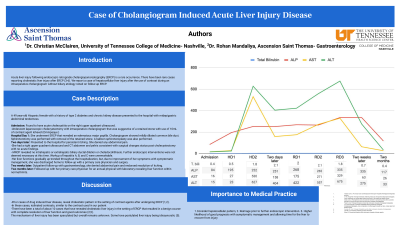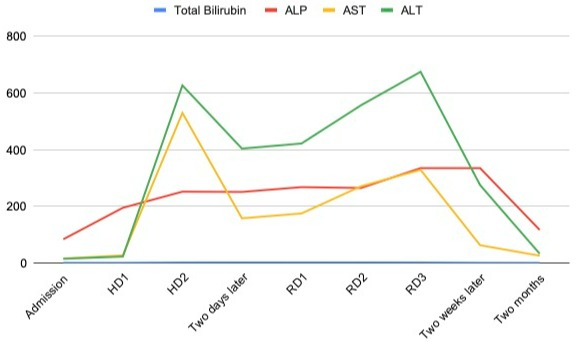Back


Poster Session C - Monday Afternoon
Category: Liver
C0545 - Case of Cholangiogram-Induced Acute Liver Injury Disease
Monday, October 24, 2022
3:00 PM – 5:00 PM ET
Location: Crown Ballroom

Has Audio

Christian McClairen, MD
University of Tennessee- Nashville, St. Thomas Midtown
Nashville, TN
Presenting Author(s)
Christian McClairen, MD1, Rohan Mandaliya, MD2
1University of Tennessee- Nashville, St. Thomas Midtown, Nashville, TN; 2St. Thomas West, Nashville, TN
Introduction: We present a female who had prolonged acute hepatocellular liver injury after undergoing a cholangiogram using Omnipaque contrast. About 10 cases of cholestatic liver injury have been reported after ERCP, however our case is unique being predominantly hepatocellular injury.
Case Description/Methods: Initially presenting with abdominal pain then diagnosed with cholecystitis, she underwent cholecystectomy with cholangiogram. She subsequently underwent ERCP due to a retained stone and discharged home the next day without notable complications. She presented to the hospital two days later with pruritus. After ruling out infectious cause and further mechanical hepatobiliary pathology, she was discharged home due to improved symptoms with symptomatic management. Transaminases gradually resolved with close outpatient follow-up at two weeks and two months.
Discussion: The exact mechanism remains unclear, liver injury due to idiosyncratic reaction from contrast was postulated. This is possibly due to local hepatic injury from the contrast agent in the biliary system. The contrast material being infused under high pressure, can have a toxic effect on the liver with disruption of canalicular plasma membranes. Systemic distribution of the contrast medium from the bile duct and the spreading of the agent extracellularly to the nearby tissues might be responsible for direct toxic liver injury. Awareness of this reaction is helpful in preventing unnecessary repeat ERCP to confirm bile duct clearance as well as liver biopsies. Prednisone may be considered if persistently elevated liver enzymes.

Disclosures:
Christian McClairen, MD1, Rohan Mandaliya, MD2. C0545 - Case of Cholangiogram-Induced Acute Liver Injury Disease, ACG 2022 Annual Scientific Meeting Abstracts. Charlotte, NC: American College of Gastroenterology.
1University of Tennessee- Nashville, St. Thomas Midtown, Nashville, TN; 2St. Thomas West, Nashville, TN
Introduction: We present a female who had prolonged acute hepatocellular liver injury after undergoing a cholangiogram using Omnipaque contrast. About 10 cases of cholestatic liver injury have been reported after ERCP, however our case is unique being predominantly hepatocellular injury.
Case Description/Methods: Initially presenting with abdominal pain then diagnosed with cholecystitis, she underwent cholecystectomy with cholangiogram. She subsequently underwent ERCP due to a retained stone and discharged home the next day without notable complications. She presented to the hospital two days later with pruritus. After ruling out infectious cause and further mechanical hepatobiliary pathology, she was discharged home due to improved symptoms with symptomatic management. Transaminases gradually resolved with close outpatient follow-up at two weeks and two months.
Discussion: The exact mechanism remains unclear, liver injury due to idiosyncratic reaction from contrast was postulated. This is possibly due to local hepatic injury from the contrast agent in the biliary system. The contrast material being infused under high pressure, can have a toxic effect on the liver with disruption of canalicular plasma membranes. Systemic distribution of the contrast medium from the bile duct and the spreading of the agent extracellularly to the nearby tissues might be responsible for direct toxic liver injury. Awareness of this reaction is helpful in preventing unnecessary repeat ERCP to confirm bile duct clearance as well as liver biopsies. Prednisone may be considered if persistently elevated liver enzymes.

Figure: Title: Liver Function Tests during clinical course
Caption: Patient's liver function test over the hospitalization, readmission, two-week outpatient follow-up, and two-month outpatient follow-up revealing fluctuating elevation in transaminases after cholangiogram performed on day of admission while total bilirubin remains within normal limits. Gradual resolution of elevated transaminases over two-week and two-month follow-up. ERCP occurred on hospital day 1.
Legend:
HD- Hospital day
RD- Readmission day
ALP- alkaline phosphatase
AST- Aspartate transaminase
ALT- Alanine Transaminase
Caption: Patient's liver function test over the hospitalization, readmission, two-week outpatient follow-up, and two-month outpatient follow-up revealing fluctuating elevation in transaminases after cholangiogram performed on day of admission while total bilirubin remains within normal limits. Gradual resolution of elevated transaminases over two-week and two-month follow-up. ERCP occurred on hospital day 1.
Legend:
HD- Hospital day
RD- Readmission day
ALP- alkaline phosphatase
AST- Aspartate transaminase
ALT- Alanine Transaminase
Disclosures:
Christian McClairen indicated no relevant financial relationships.
Rohan Mandaliya indicated no relevant financial relationships.
Christian McClairen, MD1, Rohan Mandaliya, MD2. C0545 - Case of Cholangiogram-Induced Acute Liver Injury Disease, ACG 2022 Annual Scientific Meeting Abstracts. Charlotte, NC: American College of Gastroenterology.
